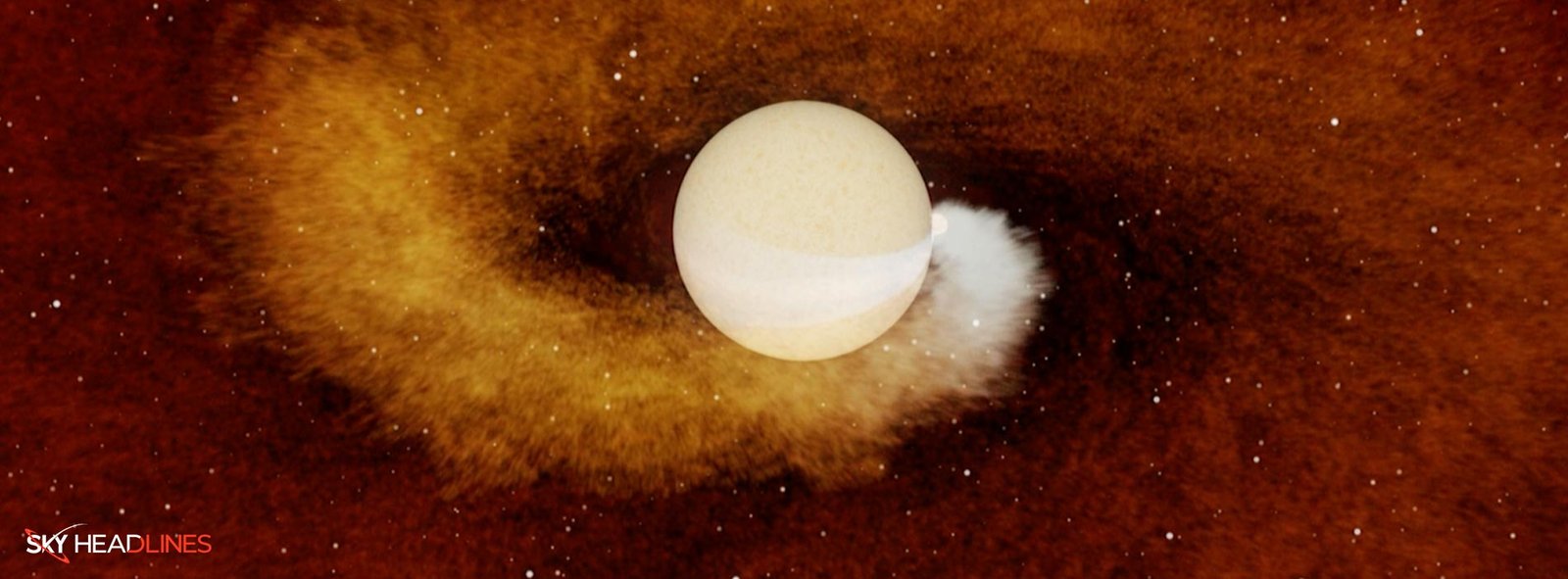An expanding dying star devours a Jupiter-sized planet. In approximately 5 billion years, our Sun will undergo a similar end-of-life phase.
What is the significance of the recent observation in which an aging star devours a Jupiter-sized planet?
The first time an aging star ate a Jupiter-sized planet was seen in a new study that came out online on May 3 in the magazine Nature. The star’s core ran dry, and it began to expand, closing the distance to the neighboring planet until it absorbed it. In around 5 billion years, our Sun will undergo a similar aging process, expanding to a diameter perhaps 100 times that of today and becoming a red giant. During that period of rapid expansion, it will swallow up Mercury, Venus, and maybe even Earth.
While it had been speculated by astronomers that some red giant stars eat planets in their vicinity, this had never been directly observed until now. “This type of event has been predicted for decades, but until now we have never actually observed how this process plays out,” said Kishalay De, an astronomer at the Massachusetts Institute of Technology in Cambridge and the study’s lead author.
What is ZTF SLRN-2020, and how did NEOWISE uncover this phenomenon?
NASA’s Jet Propulsion Laboratory-managed NEOWISE (Near-Earth Object Wide Field Infrared Survey Explorer) spacecraft and a network of ground-based observatories uncovered the phenomenon, which has been given the formal name ZTF SLRN-2020. The planet was probably about the size of Jupiter, and it circled its star even closer than Mercury does around our Sun. The red giant phase of the star’s life, which can continue for more than 100,000 years, has just begun.
The outer atmosphere of the star grew to encompass the planet as it grew in size. The planet’s orbit shrank due to atmospheric drag, causing it to disappear below the star’s visible surface, much like a meteor that burns up in Earth’s atmosphere. Because of the energy exchange, the star temporarily grew in size and brightness by a factor of about a hundred. The star’s size and brightness are back to what they were before the planetary merger, according to recent observations.
How did Zwicky Transient Facility contribute to the observation of a unique astronomical event?
The Zwicky Transient Facility (ZTF), a Palomar Observatory instrument led by Caltech that searches for astronomical events with rapid changes in brightness (sometimes in a matter of hours), detected the burst of optical light (visible to the human eye) that followed the Jupiter-Sized Planet demise. De was using ZTF to look for novae, which occur when one star’s hot gas is consumed by another star’s dead, collapsed core (called a white dwarf). Even though novae are always surrounded by flows of hot gas, subsequent ground-based telescope observations of the flash revealed much cooler gas and dust surrounding the star, making it look unlike anything De had ever seen before.
As a result, he looked to the NEOWISE observatory, which does a six-monthly infrared (light with longer wavelengths than visible) survey of the whole sky. The observatory, officially called WISE when it was released in 2009, creates maps of the whole sky that show astronomers the evolution of objects through time.
Thanks to the combined efforts of ZTF and NEOWISE, astronomers were able to observe and study this rare event in great detail, shedding new light on the process of star devours and the formation of cosmic structures.
Observation and analysis of NEOWISE:
De examined the NEOWISE data and discovered that the star brightened nearly a year before the flash was discovered by ZTF. Dust (which emits infrared light) was accumulating around the star, explaining the apparent brightening. Dust, according to De and coworkers, shows that the planet put up a struggle before collapsing under its own weight as the bloated star drifted to its death. The gas would have cooled as it traveled across space, turning into dust in much the same way that water vapor condenses into snow. More gas was ejected into space during the star-planet collision, resulting in more dust seen by NEOWISE and ground-based infrared sensors.
“Very few things in the universe brighten in infrared light and then brighten in optical light at different times,” said De. “So the fact that NEOWISE saw the star brighten a year before the optical eruption was critical to figuring out what this event was.”
Kishalay De prediction:
Since the planets Mercury, Venus, and Earth are many times smaller than the Jupiter-size planet in the ZTF-captured event, De predicts that the light show will be much more subdued when our Sun becomes a red giant and star devours Mercury, Venus, and possibly Earth in five billion years.
“If I were an observer looking at the solar system 5 billion years from now, I might see the Sun brighten a little, but nothing as dramatic as this, even though it will be the exact same physics at work,” he said.
What does the recent discovery of a planet-eating star mean for astronomers and their observations?
Theorists believe that a small number of neighboring planets are consumed each year by red giants, the final stage of evolution for most mid-size stars. Astronomers now have a benchmark for what further such occurrences should look like, thanks to the new data.
Joe Masiero – Deputy main investigator for NEOWISE:
According to Joe Masiero, deputy main investigator for NEOWISE at IPAC at Caltech, “This discovery shows that it’s worthwhile to take observations of the entire sky and archive them because we don’t yet know all of the interesting events we might be capturing.” The NEOWISE database provides a convenient way to do just that. If we look hard enough, we might discover some buried treasure or piece of information about an object that no other observatory has uncovered.





